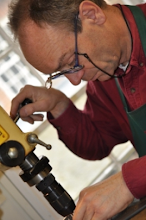When I was about 5 or 6 years old, I would spend every Sunday in the garden of my grand parents in Holland. I would find a quiet spot where I could not be seen and start imagining things. What would I do for a living when I grew up? Where would I live? Would I have a wife and children? What would I look like as a grownup? Invariably, during these moments of bliss, the village church bell would ring. Today, hearing the bell of any church clock harks me back to this world of wonder.
A failed attempt to get permission to try my hand at repairing the Forest Row village church clock convinced me to approach the Resources Manager at Michael Hall for permission to try and get the clock house clock going again. A nod and a wink later, I was up there in the bell tower trying to understand what is what. My one year training at West Dean College in Chichester had prepared me to repair antique clocks. I had practiced on quite a number of them, but a real tower clock (or “turret” clock as we say in the trade) was not on the menu in Chichester. Of course, we had learned about, seen and touched the oldest still running clock in the world (from 1386) in Salisbury Cathedral made by three Dutchmen at the request of Bishop Erghum. That clock does not have a dial. It only rings a bell. More than sufficient when most people worked on the land. The bell told them the essentials.
When William Nevill (aka Lord Abergavenny) bought Kidbrooke Park in 1734 turret clocks had dials by then. It must have been William who put this clock in our clock house. A plaque on the clock says it was made in 1736 by Joseph Pattison (“Jos Pattison Fecit 1736”). Joseph (according to my clockmaker’s bible) lived in Chester in 1767 and only worked on watches. So who should I believe? If only the clock could speak.
As the picture shows, despite its almost 300 years, it is still a fine specimen. But when it comes to antique clocks, never believe what you see on the name plate. I am always tempted to misread inscriptions like the above as “Jos Pattison faked it in 1736”. Many clocks we hold for antiques have been mixed and matched with other clocks, to such an extent that we can never be sure we look the original in the eye.
The bell in the clock house is from later (1802). Thomas Mears made it in London. There must have been an earlier bell that burst in two. By the time Lord Abergavenny decided to sell Kidbrooke in 1803, the buyer must have insisted on this new bell. The buyer wasn’t exactly a nobody either: Charles Abbot, Speaker of the House of Commons.
Our clock just has an hour hand. Minutes did exist, but did not have the same sense of urgency as today. Indeed, clocks were set on sundial time. So, different places in England had their own time. Clocks were only synchronised throughout the country when trains started running.
Teachers, parents, maintenance staff and turret clock experts helped me restore the clock. It is now ready to begin a new life on midsummer’s day when the bell will strike the hours from midday onwards. I will sit somewhere in a quiet corner in Kidbrooke Park to review my life while the bell will ring in the future. All is well.
Marc ter Kuile, parent and clockmaker

